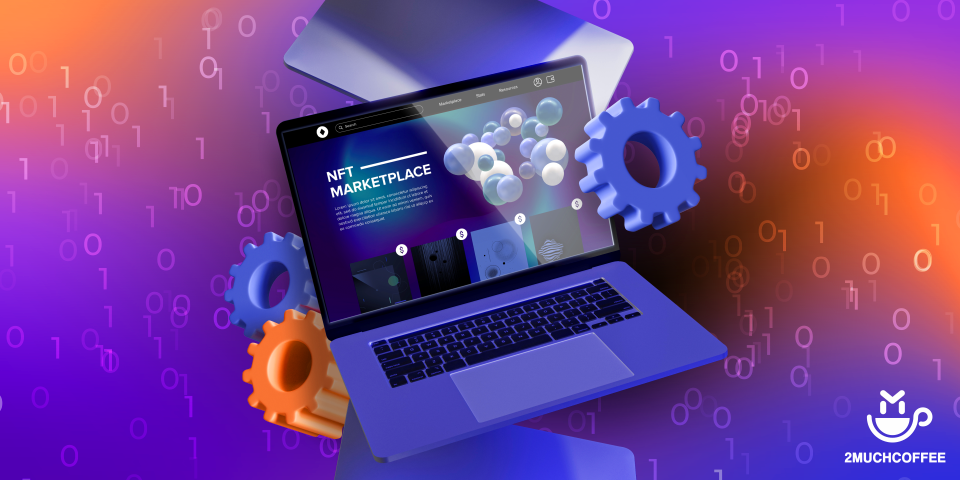Тoday, such popular NFT marketplace platforms as Rarible, OpenSea and NBA Top Shots significantly encourage NFT development. The research published on NonFungible.com says that the total value of NFT transactions in 2020 increased by 299% compared to 2019 and exceeded $250 million. Experts predict that non-fungible tokens will be the driving force behind the virtual economy in the coming 10 years.
In case you know little about what is an NFT, here is the most common FAQ about NFT or you can check out 50+ materials about NFT.
The NFT marketplace is expected to grow tremendously, and developing an NFT marketplace is a great opportunity. This article aims to analyze how to build an NFT marketplace on the example of OpenSea. We are going to cover where to start with NFT marketplace development, what features to include, and what to look for when building such a marketplace.
We recently made a design for the NFT marketplace -- Cosmo, which lets everyone create and sell crypto-collectibles. You might want to check out the full case on our Behance.
How Does an NFT Marketplace Work?
Unlike Bitcoin or Ether, you cannot directly exchange non-fungible tokens on various crypto exchanges. To buy and sell NFTs, you need special platforms.
NFT marketplace is a platform that allows users to create, store, buy and sell non-fungible tokens. In most cases, the tokens can be either auctioned or purchased at fixed prices. To use the NFT marketplace, users have to have a crypto wallet (like MetaMask) to store the cryptocurrency in order to be able to complete transactions.
NFTs can be implemented on any blockchain that supports smart contract programming. Thus, most NFTs are built on Ethereum using ERC-721 and ERC-1155 standards. Unlike regular tokens, which are fungible and have the same value, each NFT is unique and cannot be replicated, replaced, or split into parts.
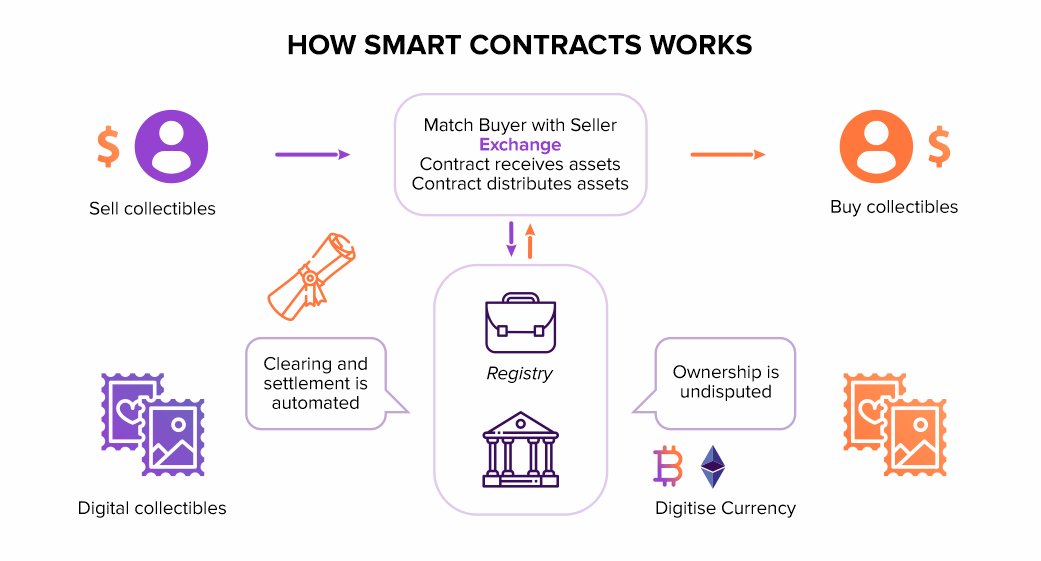
Since NFTs are empowered by smart contracts (aka self-executing contracts), each token contains a set of unique information (metadata) recorded in its smart contract, and a blockchain provides its immutability and security. To build an NFT marketplace, we need to create a token protocol, usually on the Ethereum network. This is a special group of smart contracts that ensures the implementation of certain functionality of marketplace features. Further, this protocol is integrated with the marketplace system.
Now let's talk about how NFT marketplaces work from the client-side. For the most part, all NFT auction platforms share a common flow. First, a user needs to sign up for a platform and integrate a digital wallet to store NFTs and cryptos. The registration process on the platform is directly related to a crypto wallet, basically, you sign up with your wallet. Then the user can create his collection by loading items to display his work. The user can also choose which payment tokens he'd like to accept for his art and set a secondary sales fee if the platform suggests it.
The next step is listing items for sale. The user can select a bid for an auction or a fixed price. When listing an item for sale, a transaction is created that launches a personal trading smart contract for the user wallet. The platform may require collection moderation, and after approval, your NFTs will appear on the list for sales, and you can accept bids. Usually, NFT marketplaces charge some fee on the purchase amount.
NFT Marketplace Development: Where to Start
Now that you know how NFT marketplaces work, it's time to discuss your project in more detail. If you wonder how to develop an NFT marketplace, we would suggest you start with the part of business logic. As with any other software product, you need to know who you are building your platform for and what problems it will solve. You need to decide which types of NFT you are going to build your marketplace for since the whole structure depends on this. Thus, you can choose art, music, videos, in-game accessories, sports, digital real estate, etc..
We suggest creating a user persona to indicate the goals, needs, and pain points of the potential NFT marketplace users.
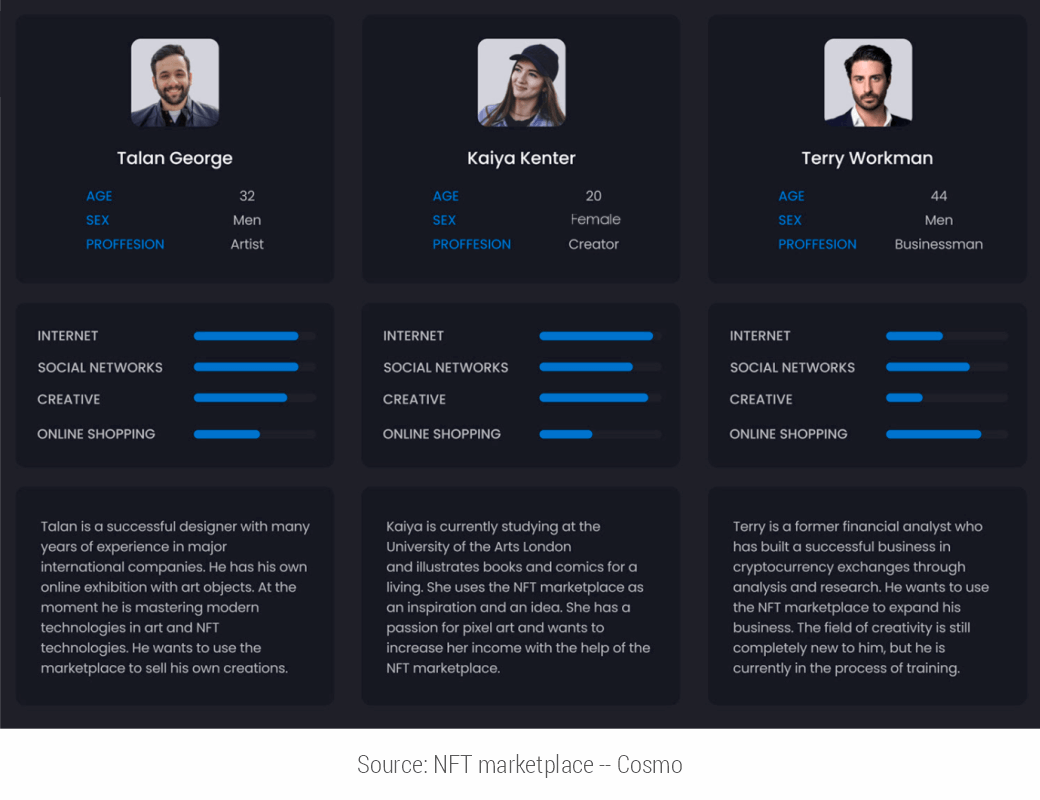
In order to use the OpenSea marketplace, a user needs to have an Etherium wallet. By default, they suggest creating a MetaMask. There are available other wallet options like Bitski, Formatic, WalletConnect, WalletLink, Arkane Network, Authereum, and Torus. So, as part of business logic think through the wallet integrations you can offer to your users.
Next, you have to decide on a list of features and choose one of several options of technical implementation of your idea.
Main NFT Marketplace Features
NFT marketplace combines marketplace and auction platform features. Users should be able to create their own collectibles and sell them. Also, different marketplaces offer some additional functionality to attract users and make their user experience exceptional. Start your list with core platform features that will allow users to carry out basic operations:
Main feed
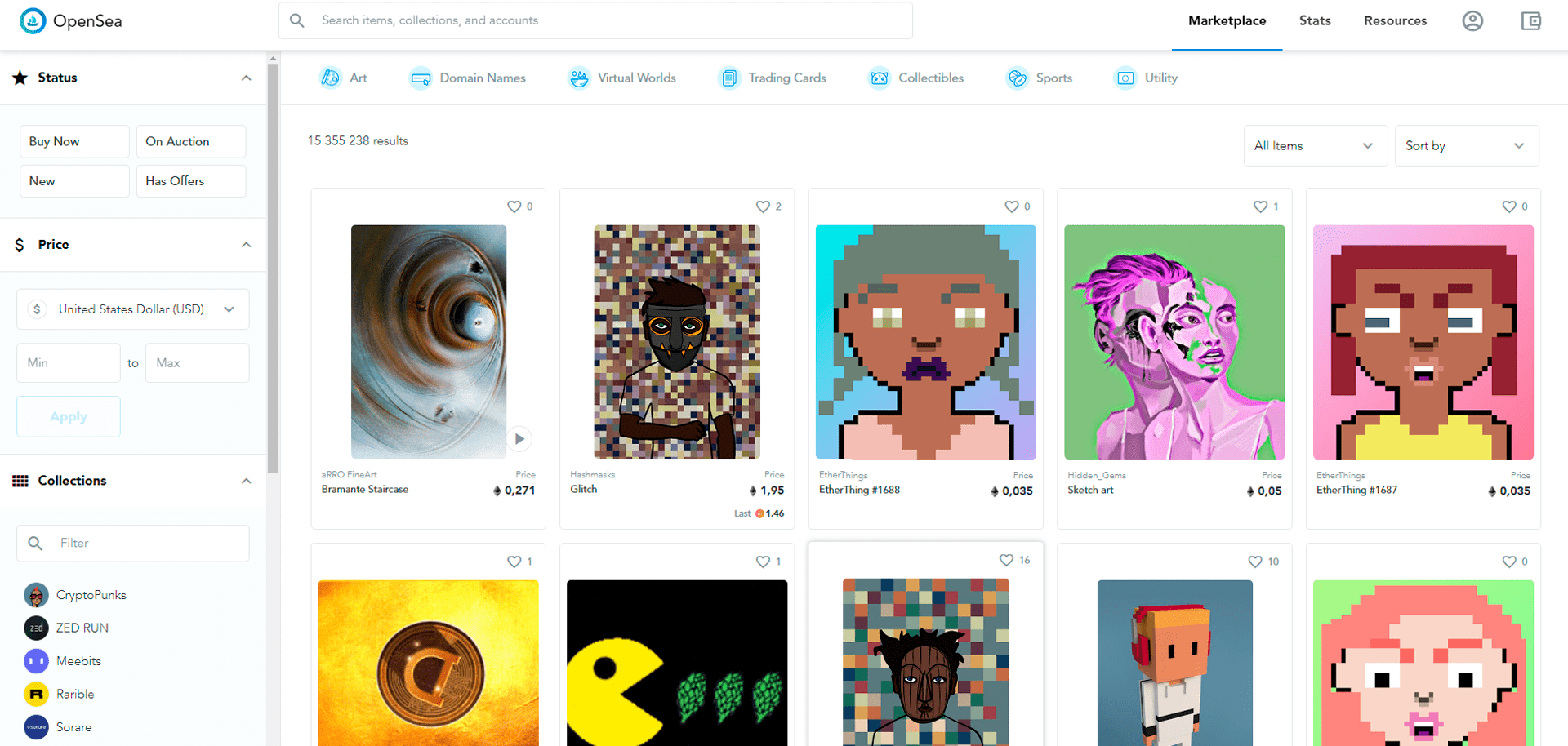
The NFT auction platform is a marketplace, so it should have all the necessary information about an item: status, price, preview, bids, owners, price history, etc. OpenSea’s home page displays the list of whole items introduced in the marketplace. The platform allows a user to choose the desirable item based on the status, price, collections, chains. The mentioned information is placed on the right side to the main feed.
Categories and Filters
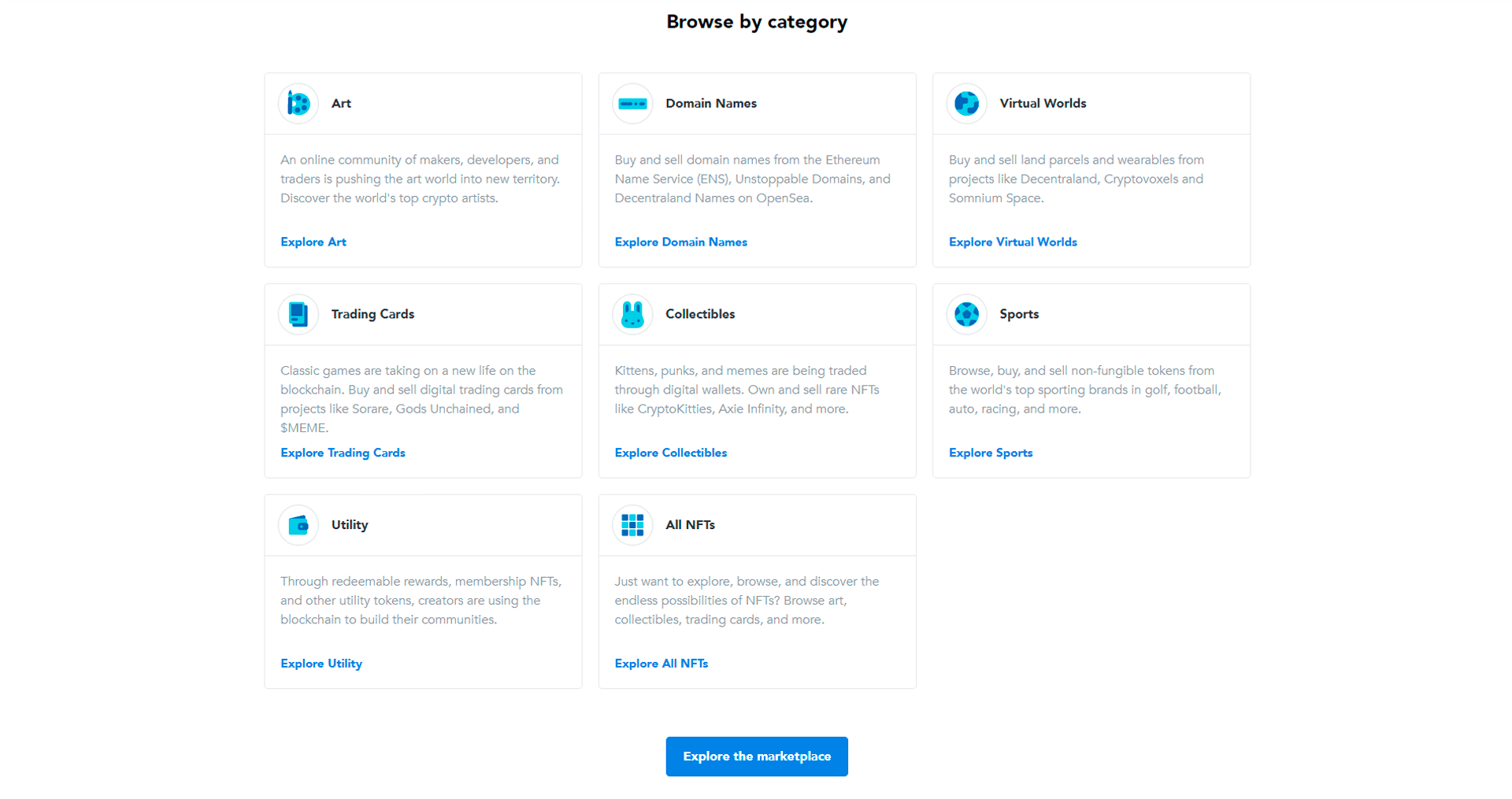
As with any marketplace, your platform should support category management and tagging to make it easier for users to find collectibles they are interested in. Implement a search bar on the site, add categories. For example, OpenSea divides items into the following categories: Art, Domain Names, Virtual Worlds, Trading Cards, Collectibles, Sports, Utility. You can choose yours.
Filters also make it easier to navigate a site, especially if there are a lot of collectibles on the platform. Give users the possibility to select items by category, payment method, collection, listing status (e.g. “new”, “has offers”, etc.). This will significantly reduce the time between NFT selection and purchase.
Trading History
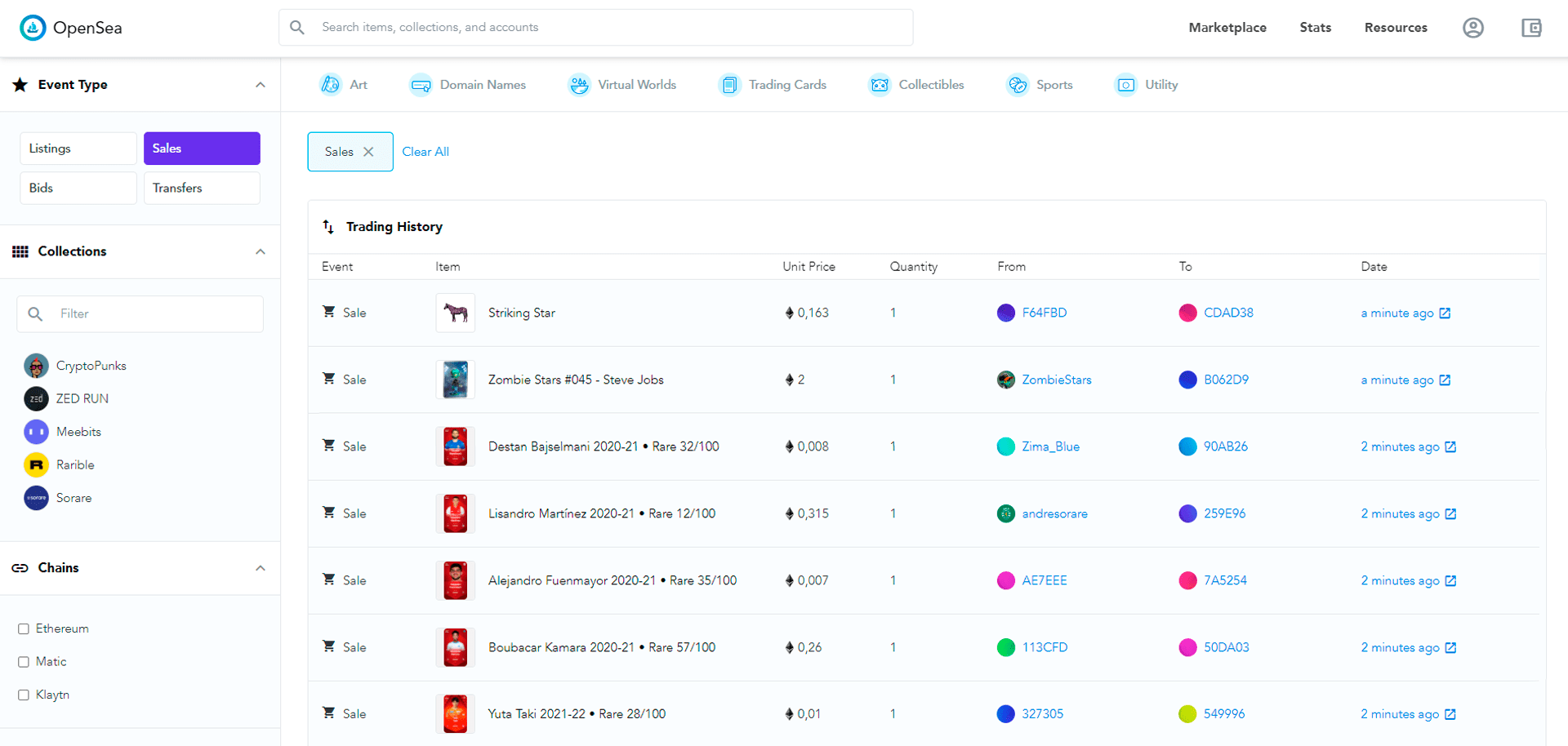
Like any auction-like marketplaces, the platform should have a Trading History. The page will include all the activities like offers, listings, creates). Basically, it will be the history of all actions on the marketplace. For example, OpenSea provides the following information: event, name of the item, price, quantity, sellers, buyers and date of purchase.
Rankings
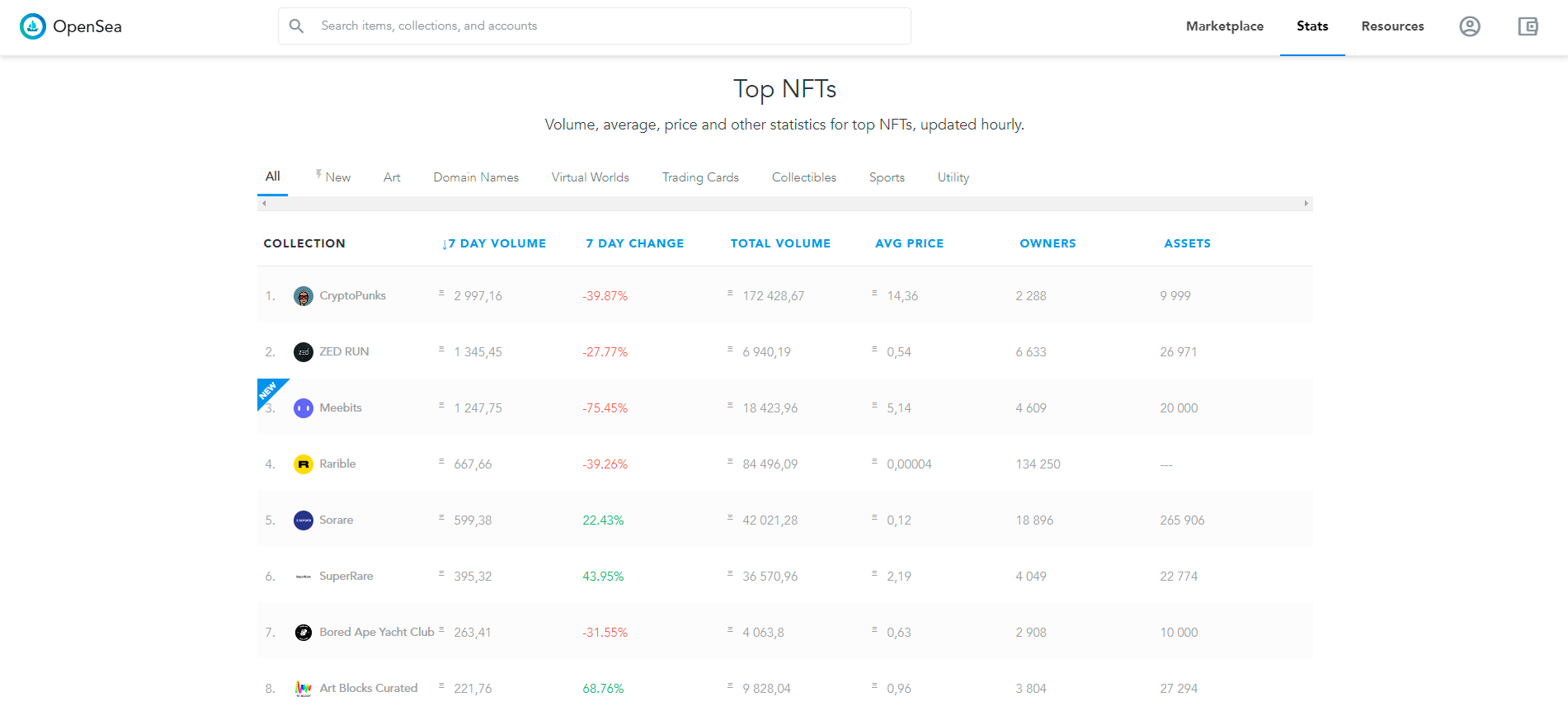
The ranking page helps users to monitor top statistics for non-fungible tokens. The section displays the top items of each category, sorted by the volume of turnover. The information is updated hourly.
Wallet
Your users need wallets to send, receive and store cryptocurrencies and non-fungible tokens. The easiest way to do this is to provide a user with a connected wallet that he already uses. For example, OpenSea offers platform members to connect one of the wallets of their choice: MetaMask, Bitski, Formatic, WalletConnect, WalletLink, ArkaneNetwork, Dapper, Authereum, or Torus. So, the list of wallets must be completed to ensure support and integration by the platform.
Create listings

The process of NFTs submission and creation of the collection should not take long. Think about the flow and most likely you need something like OpenSea's Collecting Manager to easily manage collections and items. On the new item creation page, a user should be able to upload a file and fill in the basic token properties such as name, external link, description, tags, etc..
Sell and auction
The development of the auction mechanism for your platform is one of the most critical parts of the project. You need to provide bidders with an easy-to-use and efficient NFT buying system. It is better to include the bid expiration date in the form to give users more control over their bids. Plus, the auction watchlist allows viewing details about the current status of bids.
How to Build an NFT Marketplace?
You can find some ready-made tools for building non-fungible token marketplaces. For example, OpenSea offers an SDK that allows you to create such a platform using OpenSea's infrastructure, but with your design on the top.
OpenSea's SDK opens up enough opportunities for building a functional NFT marketplace, including the ability to sell items for your own ERC-20, make a profit, enable private listings, bulk transfers, and more. The SDK allows you to create ERC-721 or ERC-1155 (semi-fungible) items. Also, you don't need to deploy your own smart contracts. This toolkit greatly simplifies the NFT marketplace development process with ready-made blocks.
However, if you don’t have a technical background, it will be quite difficult for you to do it yourself. Plus, take into account that while developing the NFT marketplace with OpenSea's SDK you 1) will be fully dependent on OpenSea; 2) OpenSea will take 2.5% on all transactions. There is currently no option to purchase the White Label upfront and remove their 2.5% fee.
In some cases, off-the-shelf toolkits may not meet all project requirements. This is when the custom NFT marketplace development comes into play. With the support of an experienced development team, you can create an NFT marketplace with any functionality from scratch. The NFT marketplace development consists of the following steps:
Business analysis. At this stage, you need to describe the business part of your project: for whom your product is being created, which features you need to implement, which user flow to build. The more precisely you study user behavior, the more user-friendly solution you can create. The task is to build a simple yet effective marketplace architecture.
UI/UX design. When developing a marketplace, the UI/UX part is crucial. The user interface should be clear and simple. Good UI/UX is the golden mean between usability and a nice look and feel of your platform. We highly recommend consulting a professional designer when creating the UI/UX for your product. If users have problems interacting with your marketplace, you gave the time and money away, and no talented developers can fix that.
Smart contract protocol and back-end development. The back-end is the logic of your platform. When designing an NFT marketplace, this step will be different from a similar step in standard custom development. The thing is NFT marketplace is a decentralized platform, so most of the data is verified on a blockchain. For instance, Ethereum allows the network to run certain scripts to make an app decentralized, so most of the backend logic is transferred to the decentralized part.
Front-end development. Choosing the best framework for your project, software developers implement all the necessary features on the client side. The main task here is to ensure fast and good performance and reliability.
Testing. You should never skip this step. Detecting and fixing bugs promptly makes you sure that your product is ready to launch. Plus, software testing allows you to make sure that your platform works as intended and meets the original project requirements. Remember that a properly tested software product provides reliability, security, and high performance.
Launching and support. Once you are sure that your platform is bug-free, it's time to launch your NFT marketplace. Many people think that this is the last step, but you need to constantly work to maintain and update your software product.
What to Look for When Building an NFT Marketplace?
Security is a prominent feature in the NFT platform regarding the transaction of tokens between traders in the marketplace. The built-in security protects from transaction loss and other unwanted activities since it is secured with private keys.
Transparency is maintained to show the user a clear view of each transaction made in the marketplace. The blockchain network ensures a bug-free payment process to have smooth transactions.
Smart Contracts are initialized by signing the agreement digitally to prevent fraud activities and eliminate the intermediaries for no commission fee. The smart contracts are written in lines of code to automate the process.
The monetization model is something you need to think about. For example, listing on OpenSea is free of charge. However, at the time of sale, the platform deducts 2.5% from the cost of the item.
Decentralization in the NFT platform enables all data to be copied and distributed to various blockchain networks. Each time a new block is introduced, the NFT platform’s network updates its blockchain to make changes.
How much does it cost to build an NFT marketplace?
In a nutshell, the time and price depend on the platform’s functionality. The more complex platform you want to build, the more money you will have to invest in marketplace development.
The same goes for the development solutions. For example, if you decide to use a ready-made solution, like OpenSea SDK that is already set to be installed, the cost will be lower. However, you need to pay attention to the various effects such toolsets will have on your business. For example, the platform that provides you with SDK will take a certain percentage of the transactions. Plus, there are no guarantees of security and your product will be depended on the platform that provides you with a ready-made solution.
At the same time, NFT marketplace development services of a reliable software development team will be slightly expensive. The reason is that their specialists will have to build a user flow, develop the functionality, and design your solution from scratch. Moreover, you need to understand that Ethereum Dapp development is a niche skill. Thus, it may be difficult to find skilled developers. That’s why the price might be higher.
At 2muchcoffee, we have a starter seed for the NFT marketplace, which already has initial functionality and solves almost all architectural issues. If you want to learn more drop us a line so we can tell you more about it.
Final Thoughts
The NFT market has grown over 299% in 2020 for more than $250 million as a total transaction. Today, NFT has stormed the online community worldwide steadily transforming every industry.
The NFT marketplace allows digital assets to be sold directly from sellers to customers. So, the exchange made in the NFT platform is charged at a significantly less fee and maintains transparency. Since NFT offers powerful ownership rights, high-level security, and immutability, it’s not a surprise that many companies worldwide are stepping forward to tokenize their own NFTs and create an NFT marketplace.
We hope this article will provide you with a basic understanding of how to build an NFT marketplace. If you have any questions, do not hesitate to fill in the form below, so we can help you to build the next big brand.
